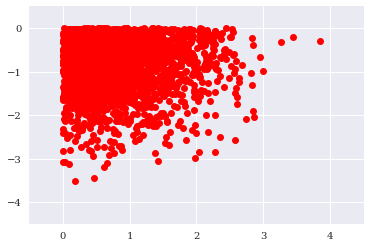[Pandas] 04 - Efficient I/O
SQLITE3接口 to Arrary
——从数据库加载数据到dataframe/numpy中。
调动 SQLITE3数据库
- import sqlite3 as sq3
- query = 'CREATE TABLE numbs (Date date, No1 real, No2 real)'
- con = sq3.connect(path + 'numbs.db')
- con.execute(query)
- con.commit()
commit 命令
COMMIT 命令是用于把事务调用的更改保存到数据库中的事务命令。
COMMIT 命令把自上次 COMMIT 或 ROLLBACK 命令以来的所有事务保存到数据库
返回值处理
返回所有值,就用 fetchall()。
- con.execute('SELECT * FROM numbs').fetchmany(10)
- pointer = con.execute('SELECT * FROM numbs')
- for i in range(3):
- print(pointer.fetchone())
- Output:
-------------------------------------------------- ('2017-11-18 11:18:51.443295', 0.12, 7.3)
- ('2017-11-18 11:18:51.466328', 0.9791, -0.01914)
- ('2017-11-18 11:18:51.466580', -0.88736, 0.19104)
保存到NumPy
第一步、通过初始化直接格式变换即可。
- query = 'SELECT * FROM numbers WHERE No1 > 0 AND No2 < 0'
- res = np.array( con.execute(query).fetchall() ).round(3)
第二步、可视化数据 by resampling,也就是少取一些点。
- res = res[::100] # every 100th result
- import matplotlib.pyplot as plt
- %matplotlib inline
- plt.plot(res[:, 0], res[:, 1], 'ro')
- plt.grid(True);
plt.xlim(-0.5, 4.5);
plt.ylim(-4.5, 0.5)- # tag: scatter_query
- # title: Plot of the query result
- # size: 60

SQLITE3接口 to DataFrame
读取整个表
一张表通常内存可以搞定,全部读取也不是避讳的事情。
- import sqlite3 as sq3
- filename = path + 'numbs'
- con = sq3.Connection(filename + '.db')
- %time data = pd.read_sql('SELECT * FROM numbers', con)
- data.head()
表操作
其实已经演变为 ndarray操作。
“与” 条件
- %time data[(data['No1'] > 0) & (data['No2'] < 0)].head()
“或” 条件
- %%time
- res = data[['No1', 'No2']][((data['No1'] > 0.5) | (data['No1'] < -0.5))
- & ((data['No2'] < -1) | (data['No2'] > 1))]
PyTable的快速I/O
HDF5数据库/文件标准。
"无压缩" 创建一个大表
表定义
- import numpy as np
- import tables as tb
- import datetime as dt
- import matplotlib.pyplot as plt
- %matplotlib inline
- filename = './data/tab.h5'
- h5 = tb.open_file(filename, 'w')
- # 有几行:多搞几行,弄一个大表
- rows = 2000000
- # 有几列
- row_des = {
- 'Date': tb.StringCol(26, pos=1),
- 'No1': tb.IntCol(pos=2),
- 'No2': tb.IntCol(pos=3),
- 'No3': tb.Float64Col(pos=4),
- 'No4': tb.Float64Col(pos=5)
- }
创建表
- filters = tb.Filters(complevel=0) # no compression
- tab = h5.create_table('/', 'ints_floats', row_des,
- title='Integers and Floats',
- expectedrows=rows, filters=filters)
新增数据
此时,表还在内存中,向这个表内添加数据。
(1) 一个关键的列表形式。
- pointer = tab.row
(2) 生成随机数填充。
- ran_int = np.random.randint(0, 10000, size=(rows, 2))
- ran_flo = np.random.standard_normal((rows, 2)).round(5)
(3) 赋值给内存中的表。
传统策略,使用了繁琐的循环。
- %%time
- for i in range(rows):
- pointer['Date'] = dt.datetime.now()
- pointer['No1'] = ran_int[i, 0]
- pointer['No2'] = ran_int[i, 1]
- pointer['No3'] = ran_flo[i, 0]
- pointer['No4'] = ran_flo[i, 1]
- pointer.append()
- # this appends the data and
- # moves the pointer one row forward
tab.flush() # 相当于SQLITE3中的commit命令
矩阵策略,省掉了循环。
- %%time
- sarray['Date'] = dt.datetime.now()
- sarray['No1'] = ran_int[:, 0]
- sarray['No2'] = ran_int[:, 1]
- sarray['No3'] = ran_flo[:, 0]
- sarray['No4'] = ran_flo[:, 1]
“压缩” 创建一个大表
创建压缩表
因rows中其实已经有了数据,所以创建的同时就同步写入文件。
- filename = './data/tab.h5c'
- h5c = tb.open_file(filename, 'w')
- filters = tb.Filters(complevel=4, complib='blosc')
- tabc = h5c.create_table('/', 'ints_floats', sarray,
- title='Integers and Floats',
- expectedrows=rows, filters=filters)
dnarray读取
读取内存数据,返回 numpy.ndarray。
- %time arr_com = tabc.read()
- h5c.close()
内存外计算
比如,处理一个若干GB的数组。
创建一个外存数组 EArray
- filename = './data/array.h5'
- h5 = tb.open_file(filename, 'w')
- n = 100
- ear = h5.create_earray(h5.root, 'ear',
- atom=tb.Float64Atom(),
- shape=(0, n))
- %%time
- rand = np.random.standard_normal((n, n))
- for i in range(750):
- ear.append(rand)
- ear.flush()
- ear.size_on_disk # 查看一下,这个E Array是个大数组
创建一个对应的 EArray
第一步、设置外存 workspace。
- out = h5.create_earray(h5.root, 'out', atom=tb.Float64Atom(), shape=(0, n))
第二步、通过外存来计算ear大数组。
- expr = tb.Expr('3 * sin(ear) + sqrt(abs(ear))') # 这里是 import tables as tb 中的 Expr,而不是import numexpr as ne
- # the numerical expression as a string object
- expr.set_output(out, append_mode=True)
- # target to store results is disk-based array
- %time expr.eval()
- # evaluation of the numerical expression
- # and storage of results in disk-based array
第三步、从外存读入内存,传的自然是“变量“,而非”workspace"。
- %time imarray = ear.read()
- # read whole array into memory
End.
[Pandas] 04 - Efficient I/O的更多相关文章
- Pandas | 04 Panel 面板
面板(Panel)是3D容器的数据.面板数据一词来源于计量经济学,部分源于名称:Pandas - pan(el)-da(ta)-s. 3轴(axis)这个名称旨在给出描述涉及面板数据的操作的一些语义. ...
- [AI] 深度数据 - Data
Data Engineering Data Pipeline Outline [DE] How to learn Big Data[了解大数据] [DE] Pipeline for Data Eng ...
- Ubuntu下安装python相关数据处理
01. Ubuntu下安装ipython sudo apt-get install ipython 02. Ubuntu下安装pip $ sudo apt-get install python-pip ...
- 数据分析04 /基于pandas的DateFrame进行股票分析、双均线策略制定
数据分析04 /基于pandas的DateFrame进行股票分析.双均线策略制定 目录 数据分析04 /基于pandas的DateFrame进行股票分析.双均线策略制定 需求1:对茅台股票分析 需求2 ...
- 04. Pandas 3| 数值计算与统计、合并连接去重分组透视表文件读取
1.数值计算和统计基础 常用数学.统计方法 数值计算和统计基础 基本参数:axis.skipna df.mean(axis=1,skipna=False) -->> axis=1是按行来 ...
- Ubuntu16.04下安装配置numpy,scipy,matplotlibm,pandas 以及sklearn+深度学习tensorflow配置+Keras2.0.6(非Anaconda环境)
1.ubuntu镜像源准备(防止下载过慢): 参考博文:http://www.cnblogs.com/top5/archive/2009/10/07/1578815.html 步骤如下: 首先,备份一 ...
- ubuntu16.04安装python3,numpy,pandas等量化计算库
ubunt安装python3 sudo add-apt-repository ppa:fkrull/deadsnakessudo apt-get updatesudo apt-get install ...
- Desktop Ubuntu 14.04LTS/16.04科学计算环境配置
Desktop Ubuntu 14.04LTS/16.04科学计算环境配置 计算机硬件配置 cpu i5 6代 内存容量 8G gpu GTX960 显存容量 2G(建议显存在4G以上,否则一些稍具规 ...
- pandas基础-Python3
未完 for examples: example 1: # Code based on Python 3.x # _*_ coding: utf-8 _*_ # __Author: "LEM ...
随机推荐
- 自定义genericUDF demo
package cn.com.dtmobile.hiveUdf; import org.apache.hadoop.hive.ql.exec.UDFArgumentException; import ...
- Jmeter接口自动化实例(使用Beanshell保存csv文件、csv参数化、setUp线程组)
很久没更新博客了,荒废了很久了,今天更新一下博客,主要记录一下子最近遇到的问题和解决方法:blonde_woman: 这篇文章主要记录的是jmeter批量跑接口中遇到的各种疑难,主要涉及到的问题如下 ...
- 程序与CPU
CPU中共有四大组件: 寄存器 控制器 运算器 时钟 寄存器:存取数值(存东西的) 控制器:负责将内存(寄存器)中的数据进行读入和写出(控制寄存器 协调者) 运算器:里面是逻辑运算单元,协助寄存器和控 ...
- Linux内核DTB文件启动的几种方式
版权: 凌云物网智科实验室< www.iot-yun.com > 声明: 本文档由凌云物网智科实验室郭工编著! 作者: 郭文学< QQ: 281143292 guowen ...
- Python数据分析之pandas基本数据结构:Series、DataFrame
1引言 本文总结Pandas中两种常用的数据类型: (1)Series是一种一维的带标签数组对象. (2)DataFrame,二维,Series容器 2 Series数组 2.1 Series数组构成 ...
- 老司机也晕车--java字符串String晕车之旅
首先声明,有晕车经历的司机请自备药物,String也可能让你怀疑人生! 第一道 开胃菜 请听题!第一道题: String hello="hello world!"; String ...
- 第8章 浏览器对象模型BOM 8.2 location对象
location 是最有用的 BOM对象之一,它提供了与当前窗口中加载的文档有关的信息,还提供了一些导航功能.事实上, location 对象是很特别的一个对象,因为它既是 window 对象的属性, ...
- P2518 [HAOI2010]计数 类似数位dp
题意 你有一组非零数字(不一定唯一),你可以在其中插入任意个0,这样就可以产生无限个数.比如说给定{1,2},那么可以生成数字12,21,102,120,201,210,1002,1020,等等. 现 ...
- CodeForces 402 E Strictly Positive Matrix
Strictly Positive Matrix 题解: 如果原来的 a[i][j] = 0, 现要 a[i][j] = 1, 那么等于 sum{a[i][k] + a[k][j]} > 1. ...
- hdu 1890 Robotic SortI(splay区间旋转操作)
题目链接:http://acm.hdu.edu.cn/showproblem.php?pid=1890 题解:splay又一高级的功能,区间旋转这个是用线段树这些实现不了的,这题可以学习splay的旋 ...
